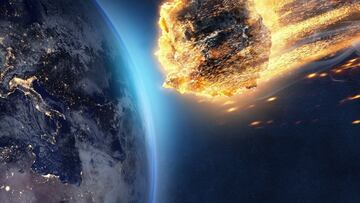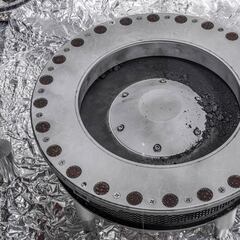How big does an asteroid have to be to pose a risk to humankind?
The Earth is bombarded daily by objects from outer space but generally they go unnoticed. However, every now and then one catches our attention.

Looking up at the Moon, one can easily make out the scars left on its surface by space debris that crashed into it sometime in the past. Here on Earth, the evidence of such violent impacts get erased relatively quickly due to geological processes such as weathering and erosion.
However, there still remain some traces. One obvious example can be found in northern Arizona which was created 50,000 years ago. According to NASA, “there are now over 100 ring-like structures on Earth recognized as definite impact craters.”
However, an asteroid or comet doesn’t have to make it all the way to the ground to be destructive as has been seen from the two most famous modern events. Fortunately, no human deaths are associated with a meteorite or the effects of one impacting in the past 1,000 years.
There are, however, accounts in Chinese records going back further, and an airburst from one wiped out a city in the Jordan Valley around 3,700 years ago. But how big would an asteroid or comet need to be which would threaten humankind?
How big does an asteroid or comet have to be to pose a risk to humankind?
The Earth is bombarded daily by objects from outer space, 100 tons according to NASA, but generally they go unnoticed. That’s because the objects are the size of dust and sand. However, every now and then slightly bigger ones catch our attention as they burn up in the atmosphere.
The good news is that government agencies are watching the skies seeking out potentially dangerous space rocks and tracking them once discovered. The ones that they are looking for are called Near-Earth Objects, or NEOs, which are either asteroids or comets whose orbits bring them within 120 million miles of the Sun. At that distance they can travel through Earth’s orbital neighborhood. However, none currently pose an imminent threat any time in the near future.
Calling all #PlanetaryDefenders! Our #SXSW panel is open for voting & we'd love your help! Our panel will explain how NASA searches for near-Earth objects to confirm they aren’t an impact hazard to Earth, and our experts have a lot to share!
— NASA Asteroid Watch (@AsteroidWatch) August 16, 2023
Vote: https://t.co/0FGH0c7WAK pic.twitter.com/qVlHaVOM9p
Roughly once every decade an object bigger than 10 meters, or over 30 feet, in size crosses paths with Earth. Generally, those smaller than 25 meters vaporize or break up in the atmosphere but they have the potential to cause damage on the surface, especially if they explode upon entry.
In 1908, a meteor perhaps 20 meters across detonated over the Siberian forest in Russia. The force of the blast, known as the Tunguska event, was equivalent to that of a 12 megaton bomb (the atomic bomb that destroyed Hiroshima was 15 kilotons) and leveled an area of around 830 square miles.
Another thought to be of similar size around 3,700 years ago wiped out the city of Tall el-Hammam in the Jordan Valley and the surrounding area couldn’t be farmed for at least 300 years. This event is credited with being the inspiration for the biblical story of Sodom and Gomorrah.
Those around 50 meters, over 160 feet, in size could cause local devastation and may or may not leave an impact crater. The crater in northern Arizona was created by an estimated 60 meter in diameter nickel-iron meteorite. This size space object hits Earth around once every 1,000 years.
Meteor Crater is a meteorite impact crater 60 km east of Flagstaff in the northern Arizona desert🇺🇸
— Copernicus EU (@CopernicusEU) June 30, 2018
It is also known as Barringer Crater in honor of Daniel Barringer who was 1st to suggest that it was produced by meteorite impact#Sentinel2 🛰🇪🇺 #AsteroidDay @AsteroidDay pic.twitter.com/W4RuIzJBkW
A space rock or ice ball 140 meters, about 460 feet, in diameter or larger that impacted over a metro area would cause a mass casualty event. It would cause regional devastation and would leave behind a crater up to one and a quarter miles across. Fortunately, this kind of destruction happens on our planet once every 20,000 years.
An asteroid or comet 1 kilometer, around two-thirds of a mile, in size or larger that hit Earth could end civilization as we know it, possibly ending humankind. It would leave a gash in the surface over six miles in diameter and cause global devastation as debris from the impact in the atmosphere blocks sunlight leading to significant cooling and vegetation dying off, resulting in mass starvation throughout the food chain. This size object is calculated to find Earth once every 700,000 years.
However, the one that would surely end practically everything and not just humankind would be an object 10 kilometers (6 miles) or bigger in diameter. This would be the equivalent of the Chicxulub Event that is believed to have had a hand in wiping out the dinosaurs.
What you see here is an asteroid crater 😳
— Curiosity (@MAstronomers) October 28, 2022
The Chicxulub crater was formed around 66 million years ago, when a large asteroid (10km in diameter) struck the Earth. Many scientists think that this event was the cause of the the Cretaceous-Paleogene extinction. pic.twitter.com/i1LlMxJnms
Related stories
The crater from that impact about 66 million years ago is estimated to have been roughly 110 miles in diameter. It’s thought that around 75 percent or more of all species on Earth disappeared. Humankind with any luck has several more millions of years until an event of that magnitude happens as it’s estimated that it’s a once every 100 million year event.
To find out just how much damage an Earth impact could cause you can check an online tool provided by the Imperial College of London and Purdue University.


